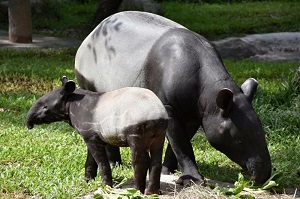
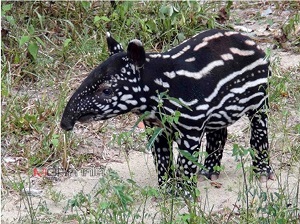
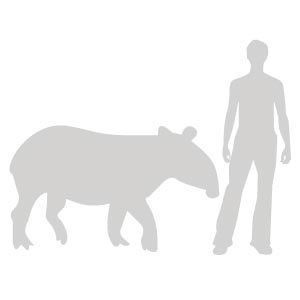
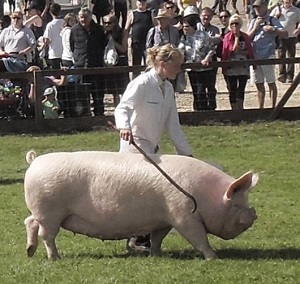
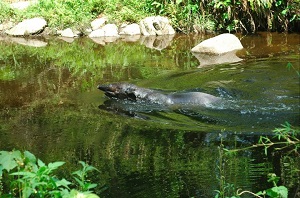
Department of English
Faculty of Arts, Chulalongkorn University
2202124
Introduction to Translation
Informative Text (Thai-English) Discussion
| The translations given on this page are neither comprehensive nor definitive. They are here to give you an idea of the range of possibilities and to spark discussion. Suggestions and comments are welcome. |
Translate
the following into English.
สมเสร็จ เป็นสัตว์เลี้ยงลูกด้วยนมที่ดูเหมือนเป็นส่วนผสมของสัตว์หลายชนิด พวกมันมีรูปร่างและตาเล็ก ๆ เหมือนหมู มีจมูกที่ยาวออกมาคล้ายกับงวงช้าง ส่วนเท้าคล้ายกับเท้าแรด ในขณะที่หางสั้นกุดเหมือนหมี
เรื่อง หนึ่งที่น่าอัศจรรย์ของสัตว์ชนิดนี้คือสีของมัน เมื่อเกิดใหม่ ๆ ลูกสมเสร็จจะมีลายสีขาว-ดำ แต่เมื่อเริ่มโตสีขนก็จะเปลี่ยน ตั้งแต่หัวจนถึงไหล่จะเป็นสีดำ ส่วนกลางตัวจะเป็นสีขาว และตั้งแต่โคนขาหลังไปจนถึงหางจะเป็นสีดำ สีของสมเสร็จเป็นเช่นนี้เพื่อให้ดูกลมกลืนไปกับสภาพแวดล้อม ไม่ให้ศัตรูสังเกตเห็นได้ง่าย
สมเสร็จ มีถิ่นอาศัยอยู่ในอเมริกาใต้ อเมริกากลาง และเอเชียตะวันออกเฉียงใต้ ปัจจุบันเป็นสัตว์ใกล้สูญพันธุ์เพราะถูกล่าเพื่อเอาหนังและเนื้อ และป่าดงดิบซึ่งเป็นที่อยู่อาศัยของพวกมันถูกทำลายไปมาก ในประเทศไทยสมเสร็จซึ่งจัดเป็นสัตว์สงวนพบมากในภาคตะวันตกและภาคใต้
เนื่อง
จากสมเสร็จเป็นสัตว์ที่รักสงบ มันจึงมักชอบอยู่ตามลำพัง นอกจากนี้
สมเสร็จยังชอบอยู่ใกล้หนองน้ำ เมื่อกินอาหาร เช่น ผลไม้หรือใบไม้สดแล้ว
บางทีก็จะลงไปแช่น้ำ หากรู้สึกว่ามีอันตรายอยู่ใกล้ ๆ
สมเสร็จก็สามารถดำน้ำหนีไปได้อย่างรวดเร็ว
 |
 |
 |
 |
 |
|
Translation 1: Grammar-Translation Method
Malayan tapirs are mammals that
look like they are a mix between many kinds of animals.
พวก
มันมีรูปร่างและตาเล็ก ๆ เหมือนหมู They have a body and small eyes
that are pig-like.
[2] มี จมูกที่ยาวออกมาคล้ายกับงวงช้าง They have a long nose that extends out like an elephant’s trunk.
ส่วน เท้าคล้ายกับเท้าแรด ในขณะที่หางสั้นกุดเหมือนหมี As for feet, they are like a those
of a rhinoceros, while their tail is short and stumpy like
a bear’s.
[3] เรื่อง หนึ่งที่น่าอัศจรรย์ของสัตว์ชนิดนี้คือสีของมัน One amazing thing about this
animal is its color. Newborn, a baby tapir has black
and white stripes,
แต่
เมื่อเริ่มโตสีขนก็จะเปลี่ยน ตั้งแต่หัวจนถึงไหล่จะเป็นสีดำ but as they grow older, the coat
color changes: from the head to the shoulders is black.
[4] สีของสมเสร็จเป็นเช่นนี้เพื่อให้ดู กลมกลืนไปกับสภาพแวดล้อม This coloring of the tapir is so that it can blend into the environment,
ไม่ ให้ศัตรูสังเกตเห็นได้ง่าย making it difficult for predators
to see them.
[5] สมเสร็จ มีถิ่นอาศัยอยู่ในอเมริกาใต้ อเมริกากลาง และเอเชียตะวันออกเฉียงใต้ Tapirs’ habitats are in South
America, Central America, and Southeast Asia
ปัจจุบัน เป็นสัตว์ใกล้สูญพันธุ์เพราะถูกล่าเพื่อเอาหนังและเนื้อ Now they are nearly extinct
because they are hunted for skin and meat,
และ
ป่าดงดิบซึ่งเป็นที่อยู่อาศัยของพวกมันถูกทำลายไปมาก and their rainforest habitat have been considerably destroyed.
[6] ในประเทศไทยสมเสร็จซึ่งจัดเป็นสัตว์สงวนพบมากในภาคตะวันตกและภาคใต้ In Thailand, the Malayan tapir, a
reserved animal, is commonly found in the west and south.
เนื่อง
จากสมเสร็จเป็นสัตว์ที่รักสงบ มันจึงมักชอบอยู่ตามลำพัง
Because tapirs are peaceful
creatures, they like to be alone.
[7] นอก จากนี้ สมเสร็จยังชอบอยู่ใกล้หนองน้ำ Moreover, tapirs like to be close
to water.
เมื่อ
กินอาหาร เช่น ผลไม้หรือใบไม้สดแล้ว บางทีก็จะลงไปแช่น้ำ After eating, for example, fruits
or fresh leaves, sometimes they will go down to soak in
the water.
หาก รู้สึกว่ามีอันตรายอยู่ใกล้ ๆ สมเสร็จก็สามารถดำน้ำหนีไปได้อย่างรวดเร็ว If they feel there is danger near,
they can dive away quickly.
|
|
Translation
2: Sample for Discussion
The Malayan tapir is a mammal that looks like a combination of many different animals. Its body and small eyes are pig-like, the longish protruding nose is elephant-like, the feet are rhinoceros-like, and its short tail bear-like. A fascinating aspect of this animal is its
color. Newborn, it is striped black and white, but older,
its coat changes into black from head to shoulders and from
the upper hind legs to tail, while white bisects the middle.
This color scheme blends well with its surroundings and
cloaks it from predators’ eyes. Quiet-seeking, tapirs are solitary. They also
like areas with water. After feeding on such diets as fruits
and leaves, they occasionally take a dip in the water. If
they feel imminent danger, they can quickly dive away. |
|
Translation
3: Sample for Discussion
Malayan tapirs are mammals that look like a composite of multiple others. The small eyes and body are reminiscent of pigs, the elongated snout of elephants, feet of rhino, and the almost nonexistent tail of bears. A remarkable characteristic of these animals is their color. Newborn calves sport black and white patterned markings that fade away, as they grow older, to black from head to shoulders, white in the midsection, and black again from top hind legs to tail. This coloring helps them camouflage, giving predators a harder time spotting them. Tapir habitats are in South and Central America, and Southeast Asia. An endangered species from poaching for skin and meat, and deforestation, they are listed as a protected wild animal in Thailand and are found mainly in the west and south of the country. Peace-loving
creatures, tapirs are generally solitary. They also like
wetlands. After a meal of fruits or leaves, they might chill
out in the water, and will duck under and swim agilely away
when sensing threat. |
Reference
Discussion
Vocabulary
Though it is the smallest (and furriest!) of tapir species, the Mountain tapir is the largest mammal in the tropical Andes mountain range. Their long hair is brownish to black, and their lips are lined in a white color. Adults have two characteristic hair-free patches on their rump.[2]
Barrel-shaped, with short, bristly hair, tapirs are surprisingly nimble and are excellent at scrambling up steep riverbanks.[3]
It [the Malayan tapir] has a distinctive coat pattern: black in the front and white in the back.[4]
As with all tapir species, their young have a “watermelon” patterned camouflage coat.[5]
[1] “American Mink,” BioKIDS, University of Michigan, http://www.biokids.umich.edu/critters/Neovison_vison/.
[2] “Mountain Tapir,” Tapir Specialist Group, https://tapirs.org/tapirs/mountain-tapir/.
[3] “Tapir,” San Diego Zoo, https://animals.sandiegozoo.org/animals/tapir.
[4] Ibid.
[5] “Mountain Tapir,” Tapir Specialist Group, https://tapirs.org/tapirs/mountain-tapir/.
Links
Tapir Topics
Eng, Karen Frances. “10 Things You Need to Know about Tapirs (Psst: There’s a Baby Tapir Named TED.” TED Blog, 14 Nov. 2014, https://blog.ted.com/10-things-you-need-to-know-about-tapirs/.
“Gradate Researches ‘Hidden Victim’ of Tiger Poaching in Sumatra: The Tapir.” USC News, 18 Sep. 2019, https://www.usc.edu.au/about/usc-news/news-archive/2019/september/graduate-researches-hidden-victim-of-tiger-poaching-in-sumatra-the-tapir “Malayan Tapir.” Tapir Specialist Group, http://iucntsg.wpengine.com/tapirs/malayan-tapir/.
“Malayan Tapir.” Denver Zoo, https://denverzoo.org/animals/malayan-tapir/.
“Malayan Tapir.” EDGE of Existence, Zoological Society of London, http://www.edgeofexistence.org/species/malayan-tapir/.
“Malayan Tapir.” Edinburgh Zoo, https://www.edinburghzoo.org.uk/animals-and-attractions/animals/malayan-tapir/.
“Malayan Tapir.” Point Defiance Zoo and Aquarium, https://www.pdza.org/animals/asian-forest-sanctuary/tapir/.
“Malayan Tapir.” Tapir Specialist Group, http://iucntsg.wpengine.com/tapirs/malayan-tapir/.
Mosco, Rosemary. “14 Terrific Facts about Tapirs.” Mental Floss, 6 May 2016, https://www.mentalfloss.com/article/79625/14-terrific-facts-about-tapirs.
Naish, Darren. “Tapir Attacks Past, Present, but Hopefully Not Future.” Scientific American, 11 Aug. 2013, https://blogs.scientificamerican.com/tetrapod-zoology/tapir-attacks-past-present-but-hopefully-not-future/.
“Tapir.” International Union for Conservation of Nature, https://www.iucn.org/commissions/ssc-groups/mammals/mammals-f-z/tapir.
“Tapir.” San Diego Zoo Wildlife Alliance, https://animals.sandiegozoo.org/animals/tapir.
“Tapirs.” National Geographic, https://www.nationalgeographic.com/animals/mammals/facts/tapirs.
“Tapirs.” San Diego Zoo, 25 May 2011, https://www.youtube.com/watch?v=n2F2LjKLYF8.
“What in the World Is a Tapir?” 2008. National Geographic, 5 Jan. 2012, https://www.youtube.com/watch?v=nlrLZJBYp34.
“What Is a Tapir?” Tapir Specialist Group, https://tapirs.org/tapirs/.
“Why Tapirs Love Spending So Much Time Underwater.” Smithsonian Channel, 17 Apr. 2019, https://www.youtube.com/watch?v=h5PZ5Zpk2rc.
กลุ่มงานวิจัยสัตว์ป่า. สัตว์ป่าสงวนในประเทศไทย (Reserved Animals of Thailand). สำนักอนุรักษ์สัตว์ป่า, กรมอุทยานแห่งชาติ สัตว์ป่า และพันธุ์พืช, กระทรวง ทรัพยากรธรรมชาติ และสิ่งแวดล้อม, http://lib.mnre.go.th/lib/book/sadpasayaunthai50.pdf.
“ข่าวดี พบ สมเสร็จ สัตว์ป่าหายากใกล้สูญพันธุ์.” คมชัด ลึก, 18 Sep. 2019, https://www.komchadluek.net/news/regional/389272.
บุญส่ง เลขะกุล. “สมเสร็จ.” ธรรมชาตินานาสัตว์. กรุงเทพฯ : สารคดี, ๒๕๔๕.
บุษบง กาญจนสาขา. “ถิ่นอาศัยและประชากรของสมเสร็จในประเทศไทย.” Wildlife Yearbook 15 (2013–15), Department of National Parks, https://www.dnp.go.th/wildlife/Wildlifeyearbook/abstract/2556-58%20Full/3.%20%E0%B8%96%E0%B8%B4%E0%B9%88%E0%B8%99%E0%B8%AD%E0%B8%B2%E0%B8%A8%E0%B8%B1%E0%B8%A2%E0%B9%81%E0%B8%A5%E0%B8%B0%E0%B8%9B%E0%B8%A3%E0%B8%B0%E0%B8%8A%E0%B8%B2%E0%B8%81%E0%B8%A3%E0%B8%82%E0%B8%AD%E0%B8%87%E0%B8%AA%E0%B8%A1%E0%B9%80%E0%B8%AA%E0%B8%A3%E0%B9%87%E0%B8%88%E0%B9%83%E0%B8%99%E0%B8%9B%E0%B8%A3%E0%B8%B0%E0%B9%80%E0%B8%97%E0%B8%A8%E0%B9%84%E0%B8%97%E0%B8%A2%20(%E0%B8%9E%E0%B8%B5%E0%B9%88%E0%B8%9A%E0%B8%B8%E0%B8%A9).pdf.
ปริญญากร วรวรรณ. “ไกล.” หลังเลนส์ในดงลึก. Matichon Weekly, 26 Aug. 2018, https://www.matichonweekly.com/column/article_126457.
ปริญญากร วรวรรณ. “คนใจสัตว์—สมเสร็จ ความลึกลับแห่งดงลึก.” Sarakadee, 16 Feb. 2010, https://www.sarakadee.com/2010/02/16/somsed/.
วัชรบูล ลี้สุวรรณ. “Big 7.” Read the Cloud, 20 Jun. 2019, https://readthecloud.co/big-7-animals-huai-kha-khaeng-wildlife-sanctuary/.
“สมเสร็จ...เสร็จสรรพในตัวเดียว.” โครงการอนุรักษ์พันธุ กรรมพืช, http://www.rspg.or.th/tis_museum/semi_articles/semi_articles_7/semi_article_7.html.
“สมเสร็จ.” Seub Nakhasathien Foundation, 11 Jun. 2017, https://www.seub.or.th/bloging/%E0%B9%80%E0%B8%81%E0%B8%A3%E0%B9%87%E0%B8%94%E0%B8%84%E0%B8%A7%E0%B8%B2%E0%B8%A1%E0%B8%A3%E0%B8%B9%E0%B9%89/%E0%B8%AA%E0%B8%A1%E0%B9%80%E0%B8%AA%E0%B8%A3%E0%B9%87%E0%B8%88/.
“สมเสร็จ.” Wildlife Conservation Information System Division, Department of National Parks, Wildlife and Plant Conservation, https://www.dnp.go.th/wildlife_it/n_web/lacegant/wildlife_reserve/page_ss.php.
“สวนสัตว์สงขลาเฮ! ต้อนรับสมาชิกใหม่ ‘ลูกสมเสร็จ’ เตรียมเปิดให้ชมความน่ารักเร็วๆ นี้.” MGR Online, 8 Oct. 2016, https://mgronline.com/south/detail/9590000101213.
Home | Introduction to Translation | Translation Resources | English Help
Last updated March 23, 2022